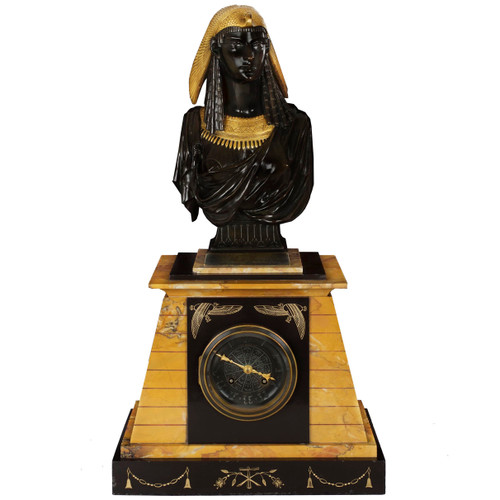catalog text
EGYPTIAN REVIVAL MANTEL CLOCK SURMOUNTED BY "BUST OF ISIS" BY PIERRE EUGENE EMILE HEBERT
Paris, circa late 19th century; cast by Georges Servant, cold-stamped verso G&S; clock movement by Japy Freres
Item # 012SFP16W
An incredibly fine casting of Isis, this coveted model is a rare find on the open market. The queen is depicted with a cool and calm demeanor, her eyes betraying no emotion or sentiment as she looks to an infinite point in the distance. Her attire is regal with a golden crown stylized as a bird and a vast choker necklace with incised designs and tear-drop embellishments being finished in brilliant gold while the rest of her body is patinated in near black. The casting quality is typical of Servant with extraordinary care shown to even the slightest details, perfect skin and surfaces throughout, crisp eyelids and minute jeweler-grade incised detailing.
The bust was retailed in many different configurations - set over a clock, standing alone as a bronze, standing alone as a bronze over an angular marble base and as a pair of bronze busts set over marble bases together with her pharaoh Ramses. The present model surmounts its original mantel clock, this a distinctly neoclassical trapezoidal form with stepped levels of alternating sienna marble and Egyptian black marble, the overall body being finished in the sienna marble with deep incised lines set at equal intervals around the black marble clock face gilt-incised with opposing Phoenix birds. The original movement is sealed with the Japy Freres marking and retains its original pendulum, though it has not been tested for operation, accuracy or duration.
Pierre-Eugéne-Emile Hebert was born in Paris in 1828 and studied under his father, a well regarded sculptor Pierre Hebert, and under Jean-Jacques Feuchére. At the age of 18 he debuted at Salon, where he continued to exhibit almost every year continuously until his death in 1893, also completing some commissioned public works. He is particularly known for “Comedy and Drama”, stone groups at the Théatre du Vaudeville and his group “The Oracle” (now at the museum in Vienna). His works are held in museums and institutions throughout the United States and Great Britain.
In its summary of Hébert, the National Gallery of Art notes that “Hébert often adjusted his style to historical subject: severe neo-Greek handling in his Thetis, Oracle, and Oedipus and the Sphinx; and stylized and rigid neo-Egyptian handling in his busts of Rameses and Isis. Some of his most intriguing work is in this historicizing mode, which provides especially useful insights into nineteenth-century French orientalism.”
Georges Servant exhibited extensively, including at the 1855 Paris Exhibition and the London Exhibitions of 1862 and 1867, winning in the latter the gold medallion referenced in the markings of his work.
For the same model by Hebert retailed as a bust on a base, see Christies, New York, 24 October 2006, lot 98 (achieved $ 14,400 USD), this also cast by Georges Servant. For a the same bust of "Isis" together with "Ramses", see Sotheby's, New York, 23 October 2008, lot 194 (achieved $ 20,000). The bust alone without a base sold at Christies, New York, 29 April 1997, lot 74 (achieved $ 8625).
Artist Listings & Bibliography:
- “Dictionnaire des Sculpteurs de l’Ecole Francaise”, Lami, 1914-21, p. 91-93
- “The Romantics to Rodin, French Nineteenth Century Sculpture”, Fusco & Janson, 1980, p. 294-95
- "Bronzes of the Nineteenth Century, Dictionary of Artists", Kjellberg, p. 376
- "E. Benezit Dictionary of Artists, Vol VI", Gründ, p. 1290
Measurements: 11 7/8" H [bronze bust]; 21 7/8" H [total height]; 12" W x 6 7/8" D
Condition Report:
Bust in exceptional original condition with beautifully preserved original patina, cleaned and polished. Clock movement complete but untested. Small chips to the slate and marble, including a larger chip to the back left corner of the slate.






































